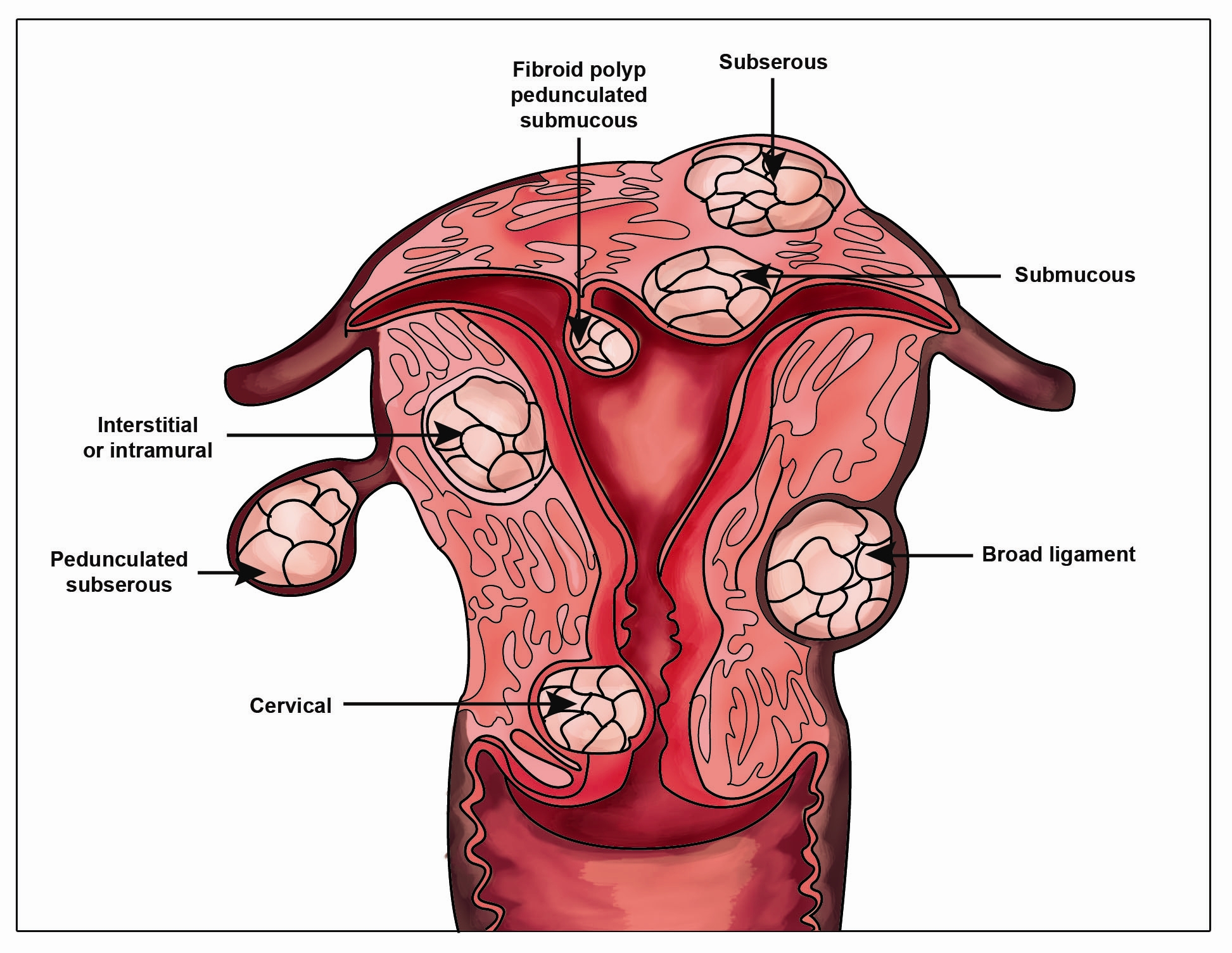
What is a fibroid?
Fibroids are benign (not malignant or cancerous) growth of the fibrous and muscle tissue of the uterus (womb). It is also known as leiomyoma, myoma or fibromyoma. Fibroids could be found in different layers of the uterus and are named accordingly as shown in the diagram below.
- Submucosal fibroid : Are found under the lining of the uterine cavity. This type of fibroid may be associated with recurrent miscarriages.
- Intramural fibroid : Are found within the muscle layer of the uterus. It is the most common type of fibroid.
- Subserosal fibroid : Are found under the lining of the uterine surface.
- Pedunculated fibroid : Are found outside the uterus but connected to the uterus by a stalk.

Diagram 1 The different locations of a fibroid
What causes fibroid?
The exact cause of fibroid is unknown but appears to be related to the female hormone estrogen. Following menopause and declining estrogen level, the fibroid size tends to shrink. Fibroid is very common with up to 30% of women in the reproductive age have it. However, it causes problem only in about 20% of these women. Symptoms associated with fibroid depend on the size and its location.
How is the fibroid detected?
It could be detected by your doctor during abdominal or pelvic examination. Sometimes, it is only picked up during a pelvic scan.
Will the fibroid size grow during my pregnancy?
Majority of the fibroid do not grow in size. However, some fibroids more than 5cm could grow especially during the first trimester. Others especially those fibroid less than 5 cm tend to either remain the same or shrink in size. 1
How can fibroid affect my pregnancy?
This depends on the size and location of the fibroid. Majority of the pregnant women with fibroid have no complications. Not surprisingly, the larger the fibroid the more complications are associated with it. Possible complications include abnormal presentation of the baby or obstructed labour requiring caesarean section, bleeding after delivery, pain during pregnancy (red degeneration),
preterm labour and
placental abruption. Most studies have not shown an increased risk of growth restriction of the baby or stillbirth associated with fibroid in pregnancy.
1What is ‘red degeneration’ of the fibroid?
This is one of the complications that may occur in pregnant women with fibroid in pregnancy where the the fibroid outgrows it blood supply leading to break down of the fibroid causing abdominal pain. Most cases settle down with analgesia and rest.
Is there any treatment for fibroid during pregnancy?
In the majority of cases, no treatment will be given during pregnancy except if there is associated ‘red degeneration’. Most doctors will opt for conservative management during pregnancy while monitor the size of the fibroid and any associated symptoms. Definitive treatment will be done only after pregnancy.
Can the fibroid be removed during caesarean section?
Removal of fibroid (myomectomy) during caesarean section have been shown in some studies to be associated with heavy bleeding1 and thus tends not to be done. However, in experienced hands removal of a pedunculated fibroid may be a safe procedure.2
What is the treatment for fibroid?
The options depend on the size, symptoms, location and fertility requirement of the patient. Mode of treatment includes:
- Myomectomy: Removal of the fibroid only
- Hysteroscopic Resection of the fibroid: Treatment for small and submucosal fibroids
- Embolisation of the uterine artery: Still under research and not available in majority of the hospital where the blood supply to the uterus is cut off leading to degeneration and shrinkage of the fibroid size.
- Hysterectomy:Removal of the uterus.
RECOMMENDED BOOKS:
[easyazon-image align=”none” asin=”0743418247″ locale=”us” height=”160″ src=”http://ecx.images-amazon.com/images/I/51BVH42OejL._SL160_.jpg” width=”101″] [easyazon-image align=”none” asin=”0446678538″ locale=”us” height=”160″ src=”http://ecx.images-amazon.com/images/I/51Hn3dZn3eL._SL160_.jpg” width=”102″] [easyazon-image align=”none” asin=”0801887003″ locale=”us” height=”160″ src=”http://ecx.images-amazon.com/images/I/51VTnFqV6JL._SL160_.jpg” width=”103″] [easyazon-image align=”none” asin=”0955891701″ locale=”us” height=”160″ src=”http://ecx.images-amazon.com/images/I/516L82u47TL._SL160_.jpg” width=”160″] [easyazon-image align=”none” asin=”0763746398″ locale=”us” height=”160″ src=”http://ecx.images-amazon.com/images/I/517nQmkParL._SL160_.jpg” width=”107″]
REFERENCES:
- Ouyang DW et al. Obstetric complications of fibroids. Obstet Gynecol Clin North Am. 2006;33:153-69.
- Kaymak O,et al. Myomectomy during cesarean section. Int J Gynaecol Obstet. 2005;89:90-3
Filed under Obstetrics Conditions | No Comments









